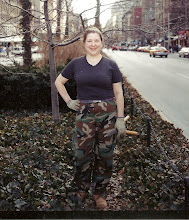 Dear Reader,
Dear Reader,This is a photograph of the flower of "Hamamalis Vernalis," in English, Common Witchhazel. I was hoping for a clearer photo but I'm new at this "nature photography" thing, so I'm still working on it!
In any case, it's January, supposedly the dead of winter, although this past weekend saw a day as warm as any spring day, 70 degrees! These little guys, though, would probably be in bloom anyway; the witchhazel is what might be called a very early bloomer (winter, before spring) or a very late bloomer (winter, after fall). This year for some reason, there is a great bloom on my witchhazel shrubs out in the Park; much more than prior years.
At a distance, the blooms are almost indistinguishable from the dead leaves which are still hanging on to the branches of the shrubs. But on closer inspection, these beautiful little red-orange flowers, which resemble four-armed octopi, are very evident. I wish I could convey their scent; it's a wonderful, cinnamony smell, surprising from such a small flower, in such a cold season.
We have another wonderful smell wafting over the Park these days; pure pine, from ground-up Christmas trees that have been mulched for us volunteers to use in the Park. We only get a tiny percentage of the discarded trees, even of those in my neighborhood. I see potentially tons of mulch, out on the sidewalk wrapped in plastic, waiting to be picked up by "New York's Strongest" (the Sanitation Department; since 9/11, almost every division of public service has an "-est"), dumped in a barge which will transport these perfectly mulchable trees to somewhere south, to then be dumped into landfill. I suppose they will help the decay process of some of the rest of the stuff that's in the dumping ground; but there is so much non-organic stuff in these places that I am afraid we're creating (hell, I know we are) timebombs that are bound to go off sometime in the future. If the landfills themselves don't actually explode or combust, the toxins that they contain will negatviely impact the surrounding environment, through the water tables, run-off, who knows. It's inevitable, though, that this can't be good for the planet.
In any case, I got my pile of lovely-smelling pine tree mulch, which will get distributed over the next several weekends. Along with raking and picking up trash, this is the only real work in the Park at the moment. Pruning doesn't start until February, when I'll begin working on my roses and other late-blooming shrubs. I'm really worried that many of the early bloomers, the quinces, forsythia and even some of the early bulbs, will be in jeopardy because of the extremely warm weather we've had over the last week or so. Many of them are either budding, or poking their heads out of the dirt, and if we have a cold spate they may freeze off and not be able to bounce back. We'll see.
Even in as unnatural a place as Riverside Park on the edge of Manhattan, in the middle of one of the most densely populated areas on earth, nature rules. I love watching the flow and changes of the seasons; even when they are as disrupted as they have been this year. Anticipating the crocus and daffodils in early spring, watching the trees come back to life, bloom, leaf, seed and then go dormant again, keeps me in touch with real, actual life, and the ebb and flow of it. I think many New Yorkers lose touch with that, even if they have pets and house plants. It's too bad, too, because there is so much nature to watch and enjoy in the City, like little, inconspicuous flowers of a shrub that has been on herbalists' lists for hundreds of years.
More to come,
Catbird

No comments:
Post a Comment